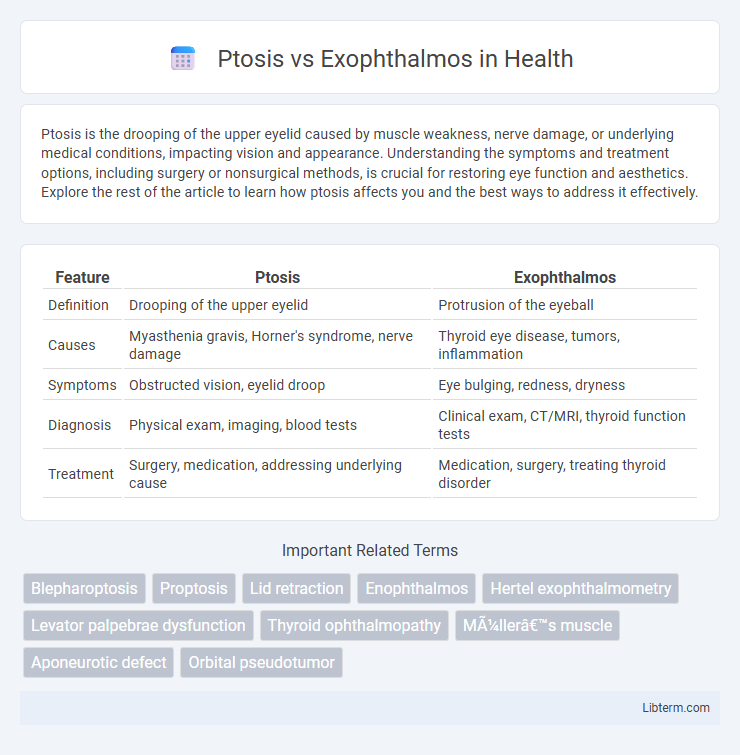Ptosis is the drooping of the upper eyelid caused by muscle weakness, nerve damage, or underlying medical conditions, impacting vision and appearance. Understanding the symptoms and treatment options, including surgery or nonsurgical methods, is crucial for restoring eye function and aesthetics. Explore the rest of the article to learn how ptosis affects you and the best ways to address it effectively.
Table of Comparison
| Feature | Ptosis | Exophthalmos |
|---|---|---|
| Definition | Drooping of the upper eyelid | Protrusion of the eyeball |
| Causes | Myasthenia gravis, Horner's syndrome, nerve damage | Thyroid eye disease, tumors, inflammation |
| Symptoms | Obstructed vision, eyelid droop | Eye bulging, redness, dryness |
| Diagnosis | Physical exam, imaging, blood tests | Clinical exam, CT/MRI, thyroid function tests |
| Treatment | Surgery, medication, addressing underlying cause | Medication, surgery, treating thyroid disorder |
Understanding Ptosis: Definition and Causes
Ptosis refers to the abnormal drooping of the upper eyelid, often caused by dysfunction of the levator muscle or damage to the oculomotor nerve. Common causes include congenital defects, age-related muscle weakening, nerve injuries, or underlying conditions such as myasthenia gravis. Understanding ptosis involves recognizing that it can impair vision and may signal systemic diseases requiring neurological or ophthalmologic evaluation.
What is Exophthalmos? Key Characteristics
Exophthalmos, also known as proptosis, is a medical condition characterized by the abnormal protrusion of the eyeball from its orbit. Key characteristics include widening of the palpebral fissure, scleral show above or below the iris, and potential exposure of the cornea leading to dryness or irritation. Often associated with Graves' disease, exophthalmos can cause vision disturbances, eye discomfort, and increased risk of corneal ulcers.
Anatomical Differences: Ptosis vs Exophthalmos
Ptosis is characterized by the drooping of the upper eyelid due to dysfunction of the levator palpebrae superioris muscle or its nerve supply, resulting in a decreased palpebral fissure height. Exophthalmos involves the abnormal protrusion of the eyeball from the orbit, often caused by increased orbital content volume, such as in thyroid eye disease, affecting the orbital fat and extraocular muscles. The primary anatomical difference lies in ptosis affecting eyelid elevation structures, whereas exophthalmos impacts the globe position within the bony orbit.
Common Symptoms: Recognizing Each Condition
Ptosis presents with drooping of the upper eyelid, often causing vision obstruction and an asymmetrical eyelid appearance, while exophthalmos is characterized by abnormal protrusion of the eyeball, leading to widened palpebral fissures and potential eye dryness. Common symptoms of ptosis include eye fatigue, increased tearing, and the need to tilt the head back to see clearly, whereas exophthalmos symptoms often involve eye redness, pain, and possible double vision due to orbital swelling. Accurate recognition of these symptoms is essential for differential diagnosis and appropriate treatment of conditions such as myasthenia gravis for ptosis and Graves' orbitopathy for exophthalmos.
Underlying Causes: Comparing Etiologies
Ptosis commonly results from neurological disorders such as myasthenia gravis, oculomotor nerve palsy, or age-related levator muscle degeneration, while exophthalmos is primarily caused by thyroid eye disease, particularly Graves' orbitopathy, and orbital tumors. Chronic inflammatory conditions, orbital cellulitis, and trauma may contribute to both conditions but manifest differently based on tissue involvement and disease pathophysiology. Understanding these distinct etiologies is critical for accurate diagnosis and targeted treatment strategies in clinical ophthalmology.
Diagnosis: Clinical Evaluation and Tests
Ptosis is diagnosed through clinical evaluation by assessing eyelid drooping, eyelid crease position, and measuring the margin-reflex distance (MRD1). Exophthalmos diagnosis involves exophthalmometry to measure the degree of globe protrusion and imaging studies such as CT or MRI to evaluate orbital pathology. Both conditions require thorough neurological and ophthalmic examinations to identify underlying causes and guide appropriate treatment.
Treatment Options for Ptosis
Ptosis treatment options include surgical correction such as levator muscle resection or frontalis sling surgery to elevate the drooping eyelid, while non-surgical methods involve the use of ptosis crutches or special glasses for mild cases. In contrast, exophthalmos management primarily targets underlying causes like Graves' disease through medications, corticosteroids, or orbital decompression surgery. Accurate diagnosis of ptosis versus exophthalmos is crucial for effective intervention and improved patient outcomes.
Management Strategies for Exophthalmos
Management strategies for exophthalmos primarily aim to reduce proptosis and prevent complications such as corneal exposure and optic neuropathy. Treatment options include corticosteroids to reduce inflammation, orbital decompression surgery to alleviate pressure in severe cases, and addressing underlying causes like thyroid eye disease with antithyroid medications or radiotherapy. Supportive care involves lubricating eye drops and eyelid taping to protect the cornea during sleep.
Potential Complications and Prognosis
Ptosis, characterized by drooping of the upper eyelid, can lead to impaired vision and astigmatism if untreated, with the prognosis varying based on underlying causes such as nerve damage or muscular disorders. Exophthalmos involves abnormal protrusion of the eyeball, frequently associated with thyroid eye disease, and poses risks like corneal exposure, optic nerve compression, and vision loss, necessitating timely intervention to prevent permanent damage. Both conditions require accurate diagnosis and management to mitigate complications and improve visual outcomes.
When to Seek Medical Attention
Seek medical attention for ptosis if drooping eyelids interfere with vision, cause persistent discomfort, or worsen suddenly, as this may signal underlying neurological or muscular conditions. For exophthalmos, urgent evaluation is necessary if the eye bulging is accompanied by pain, redness, vision changes, or difficulty closing the eye, indicating possible thyroid eye disease or orbital infections. Early diagnosis and treatment by an ophthalmologist or endocrinologist can prevent complications and preserve eye function.
Ptosis Infographic

 libterm.com
libterm.com